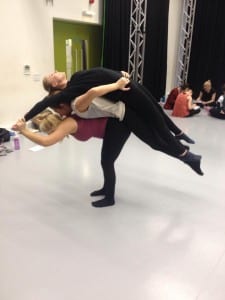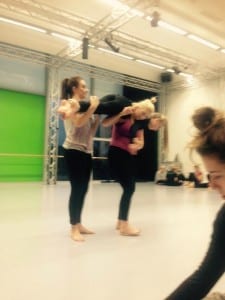We began today’s session by watching two contact improvisation videos, both looking at the play of taking and giving weight. In both videos, it was evident that the partnerships were fluid in their movements and alternated their roles as the under and over dancer. In the first clip, it was clear that the male was predominately the over dancer, subjecting the woman to the role of under dancer. However, there were movements were the female dancer did support the male dancer (Neige Christenson, 2009). On the other hand, the role of the under and over dance in the second clip was equally distributed (omegabranch, 2011). When I was watching both clips of contact improvisation, there were some similarities in the way each partnership moved. I could see that the dancers would continually stay in contact at all time, initiating movements with different parts of their body. Observing these clips inspired me to experiment with this type of movement. This is because when I perform I usually become the role of under dancer and create a static supportive base for my partner to move over. However, the clips made me aware that I can still move, even though I am the base and that will encourage my partner (the over dancer) to follow and move with me to create a more fluid piece. Both duets continuously used different parts of their body to provide bases and structures for their partner, as they succeeded not to lose contact.
As a class we used this idea of keeping contact with your partners at all times through a series of exercises. Firstly, we began with an exercise of rolling on the floor, experimenting with the notion of reaching into the space with the legs and arms. Furthermore, we practised different rolls across the room in groups of four, such as the banana helix. The banana helix roll consisted of crossing one hand over the over, reaching out into the space with the underneath arm and pushing the top leg over the underneath leg to turn the body over. Initially, as I repeated this movement I began to feel quite queasy but I discovered a new type of roll that I could incorporate and translate into my body rather than consciously rolling on the floor on my back, which is a habitual pattern of mine. The next exercise involving getting into partners and one partner lying on the other’s stomach, centres pressed together. The duet was initiated from the under dancer performing a small dance with their stomachs, which led to the over dancer responding so they too performed a small dance with their stomach. This led to a shared rhythm between me and my partner and enabled me to listen to their body to follow on to the next task of the duet. This small dance was developed into an exercise where the roles of the over and under dancer alternated without loosing contact. I find it quite easy to stay in continuous contact with my partner rolling on the floor, as I was able to engage and listen to their centre and focus on where I needed to move in the space in order for them to become the opposite role. However, this task was developed by gradually coming up to standing. At first I found this quite difficult as my partner and I were unsuccessful in moving from the floor to standing to begin with as it took us many attempts. I think it was due to the fact I have a tendency to lock my legs resulting in my feet not being stable, which therefore impacted my ability to move around the space and provide different structures for my partner. In relation to Bruce Curtis’ article Exposed to Gravity, he states “when you are in the present moment and listening to your partner’s body, the point of contact can bridge the empty space between your bodies until the dance brings you both home again”. I thought about this idea during the exercise, releasing that if I was to relax and listen to my partner’s body’s and their intention of where they want to move then I can use different surfaces of my body to stay in contact with them and create a successful duet.
The next part of the lesson focused on more advanced lifts, integrating the idea of going up from the previous lesson. We began with a simple back lift that involved one partner providing a stable and steady support and lifting their partner over their back. It was important that the partner being the support ensure their pelvis was lower than the partner they were lifting in order to carry out the exercise safely. In this lift, I feel I was able to take on both roles effectively and it was one I thoroughly enjoyed. As I continued to practice it I found myself being lifted higher as I became more confident in giving my partner my weight and I was aware of where my pelvis needed to be placed in order to be lifted. This led me to find it easier to balance on my partner’s back for a longer period of time. Another lift that I enjoyed is the jump lift. This consisted of placing my hands under my partner’s shoulder blades and giving them support as they jumped in the air and allowed me to pull their weight back into the space.
The final lifts that we learnt appeared harder than the previous ones as it took multiple attempts for me to accomplish them. This paperclip lift involved one partner placing their right arm over the back of their partner, which leads partner A to rest their arm pit on the shoulder of partner B. Partner B then supports their partner by wrapping their hand around their partner’s waist and connecting their pelvis to their partner, ensuring their’s is lower to create a stable base. Partner A then leans sideways into their partner and uses the momentum, with support of partner B to lift their feet off the ground. This is one of the lifts I felt most uncomfortable with, as it took me a while to lift my feet off the ground. I am quite concious of being lifted so I usually take the role of the under dancer when the integration of lifts are required but I would like this to experiment with this idea to push myself and include them in the contact improvisation jams. I was more confident at being the lifted than I was at being lifted as I provided a steady base but I think that was my unsuccessful attempts were due to my placement of my pelvis on my partner so it restricted me lifting my feet off the group. On the other hand, as I gradually poured more weight into my partner, I found myself becoming more successful and I believe that with more practice I can execute the lift more effectively. The other lift that I found difficult was the shoulder lift, as it involved being at a much higher height. Although I found these lifts particularly difficult, I would like to integrate more lifts into my performance as I am interested in exploring more with levels as I tend to stay quite grounded and move further away from my habitual movements.
At the end of the lesson, the class participated in a round robin. I have never been involved in a round robin so it was interesting to experience this and have the chance to observe class mates. At the beginning of the semester I would be reluctant to involve myself as I would be aware that people were watching me and I wouldn’t want to embarrass myself. However, I didn’t feel bothered about involving myself in my circle, it was just a matter of finding the correct time to go in and perform. However, as I was watching the round robin I realised there wasn’t a right time to go into the circle, it was more about taking the invitation and involving myself. Throughout this experience, I used more levels, pushing myself to work at a higher level and performing at much faster pace than previously. This was evident in the counter balance when Alice and I ran across the room and rolled on the floor at a faster speed.
In this week’s jam my initial aims were to alternate my roles equally as an under and over dancer and incorporate lifts. I didn’t feel successful in this jam as I felt I only incorporated some of my aims. My role as the under and over dance were equally distributed and I initiated the majority of movements with different people I don’t usually work with. Although I did find it difficult to initiate lifts, which is mainly due to the fact I am still hesitant in incorporating them into my improvisation but I also struggle to include them because I frequently find myself on the floor and I am unsure of how to get from the floor to standing. Therefore, this is a hurdle I need to overcome, as I aspire to include them in my performance.
Bibliography
Omegabranch (2011) Contact Improvisation Mirva Mäkinen & Otto Akkanen. [online] Available fromhttp://www.youtube.com/watch?v=YMLbWxujoGw [Accessed 13 November 2014].
Christenson, N. (2009) The play of weight. [online] Available from http://www.youtube.com/watch?v=Ltq6y06E8ew [Accessed 12 November 2014].
Curtis, B. (1988). Exposed to Gravity. Contact Quarterly/ Contact Improvisation Sourcebook I, 13 156-162.


